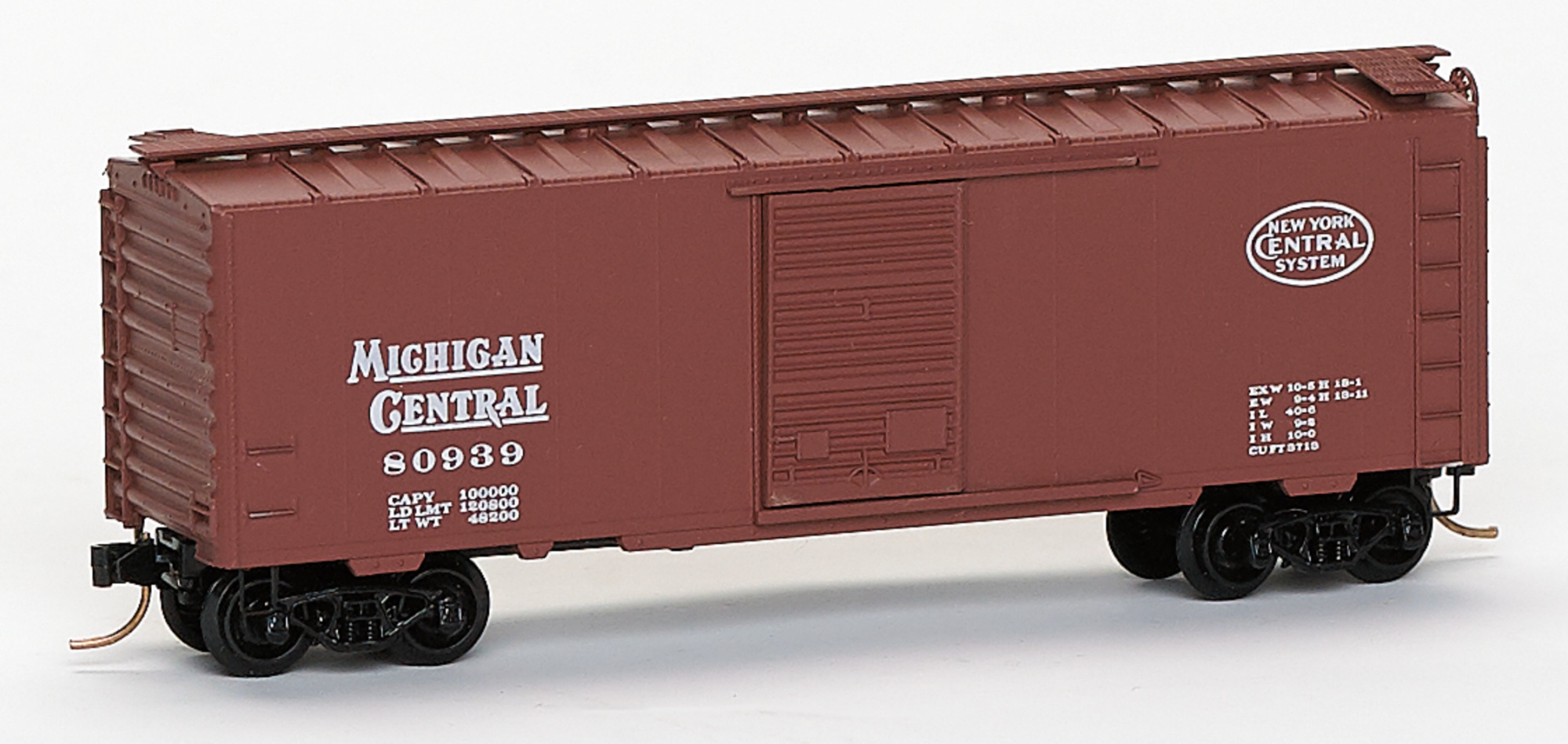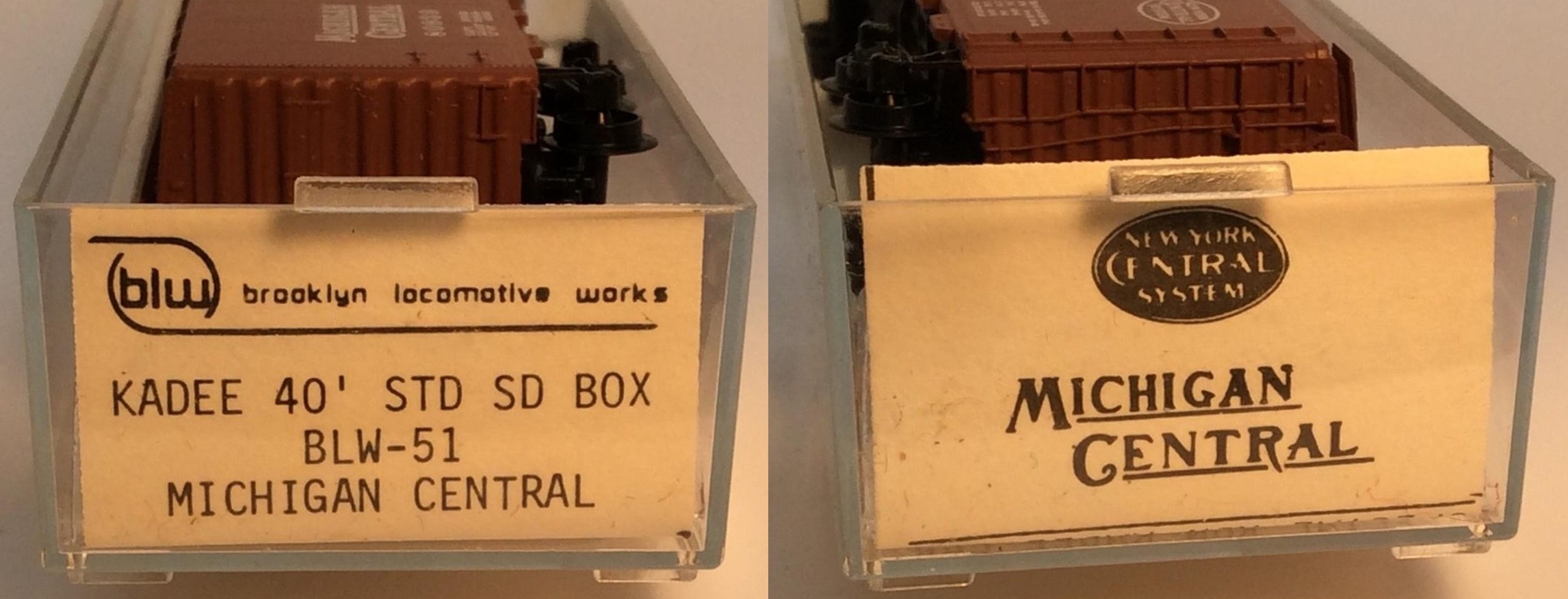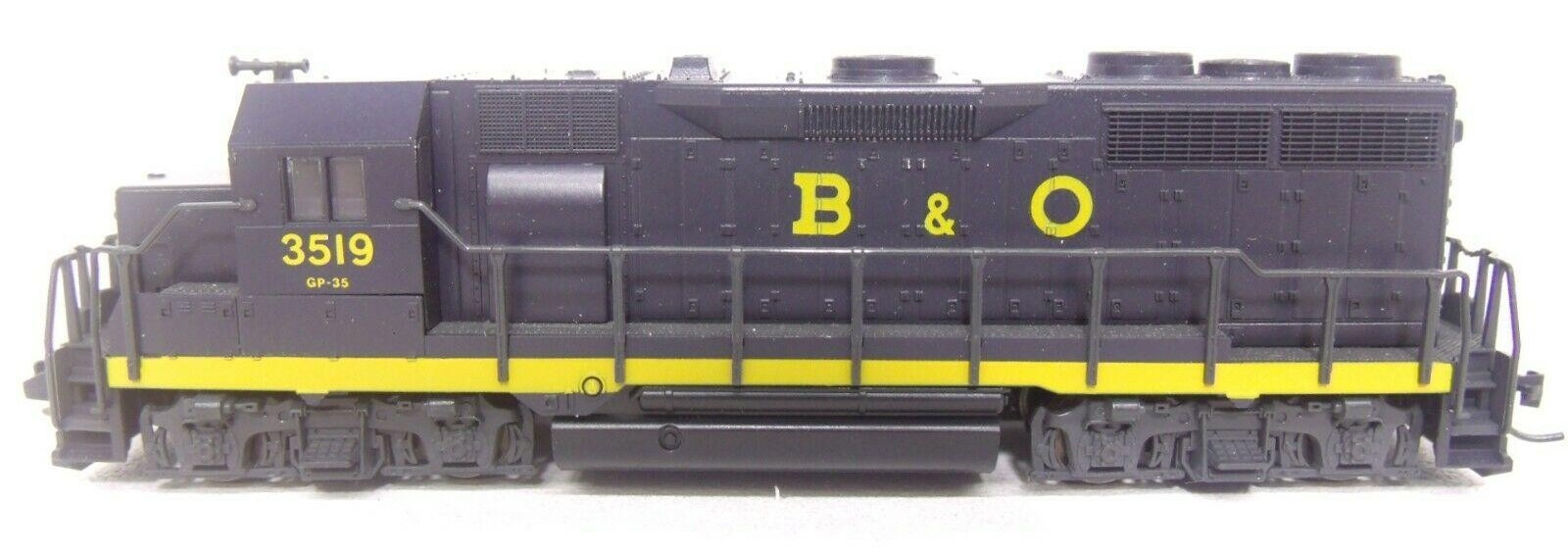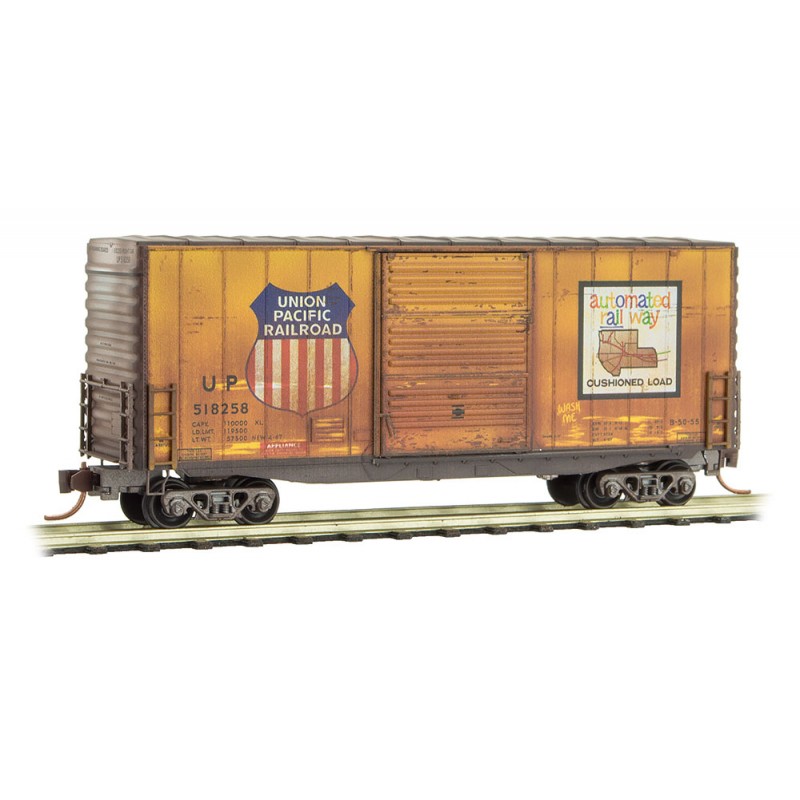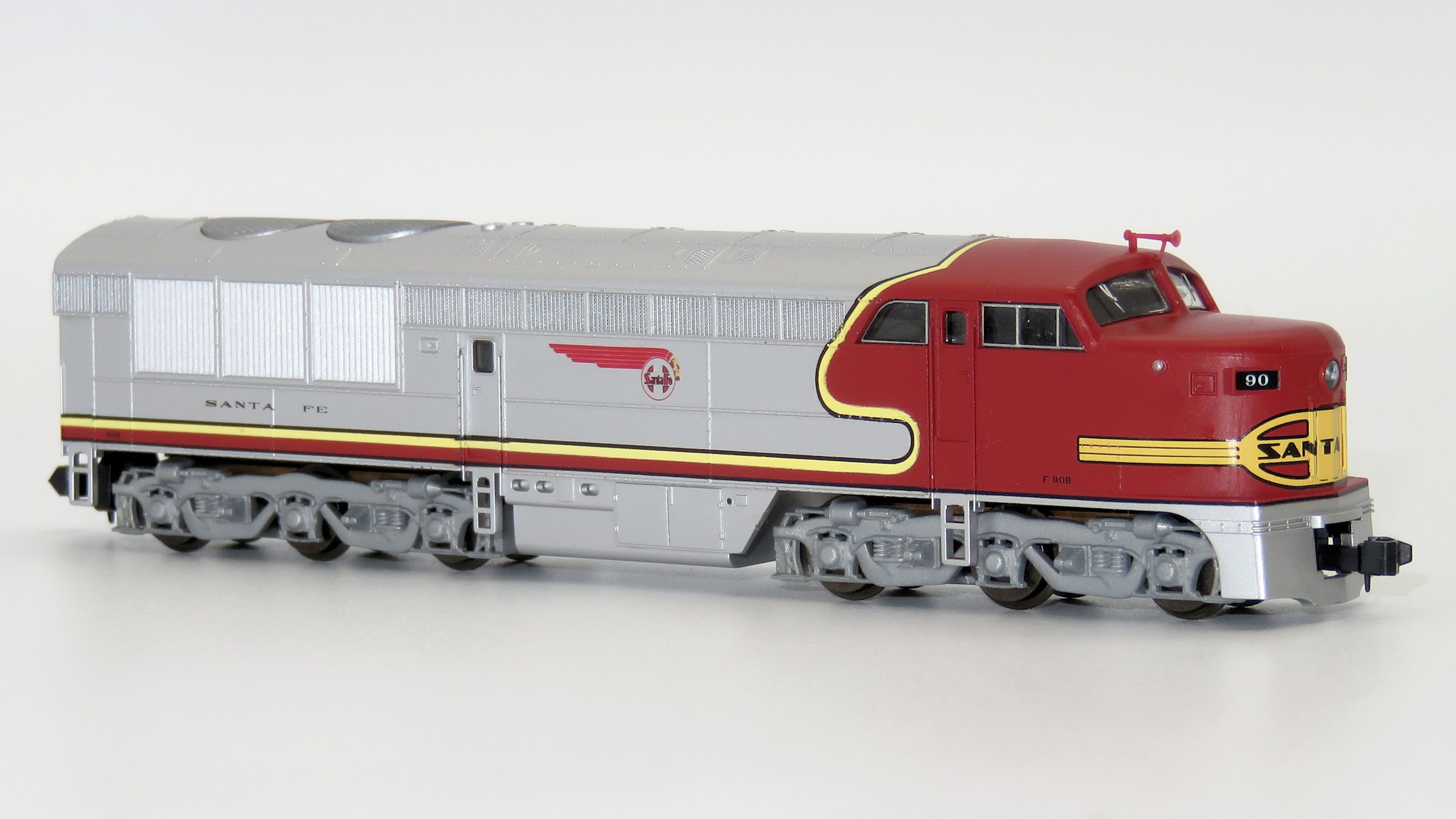Model Information: This is Micro-Trains first body style. It was introduced in 1972. Its is a model of a Pullman-Standard PS-1 boxcar from circa 1957. Micro-Trains does not market it as a PS-1 so as to allow themselves some latitude so they can use this car to model non-PS prototypes. Hundreds of different releases have used this body style in various paint schemes and road names. They are equipped with 6' sliding doors, either Youngstown (4/5/4 rib pattern) or Superior (7 panels). It is not a model of a "modern" steel boxcar as the length (40 foot) and the roofwalk are more typical of the transition era (1939 - 1957).
In 2019, Micro-Trains started releasing this model with new body-mounted couplers attached to a new underframe.
In 2019, Micro-Trains started releasing this model with new body-mounted couplers attached to a new underframe.
Prototype History: The 40' Boxcar is widely known as one of the most popular freight cars used by railroads as they transitioned from steam to diesel. In particular the Pullman Standard or PS-1 design was one of the most popular and was widely used by North American railroads. These boxcars were built beginning in 1947 and share the same basic design, with certain elements such as door size, door style or roof type varying among the different railroads and production years. When production of these cars ceased in 1963, over 100,000 had been produced.
So just what is a PS-1? Well the simple answer is it is any boxcar built by Pullman Standard from 1947 on. The design changed over the years – sometimes subtly, sometimes for customer request, and sometimes in a larger way. In general, most PS-1’s built from 1947 to 1961 share the same dimensions and basic construction techniques. These cars all had a length of 40′, a height of 10’5″ or 10’6″, welded sides and ends and roof of Pullman’s own design. The greatest variation was in the size and style of doors used. Pullman Standard also offered 50′ and later 60′ boxcars – also with the PS-1 designation.
So just what is a PS-1? Well the simple answer is it is any boxcar built by Pullman Standard from 1947 on. The design changed over the years – sometimes subtly, sometimes for customer request, and sometimes in a larger way. In general, most PS-1’s built from 1947 to 1961 share the same dimensions and basic construction techniques. These cars all had a length of 40′, a height of 10’5″ or 10’6″, welded sides and ends and roof of Pullman’s own design. The greatest variation was in the size and style of doors used. Pullman Standard also offered 50′ and later 60′ boxcars – also with the PS-1 designation.
Road Name History: 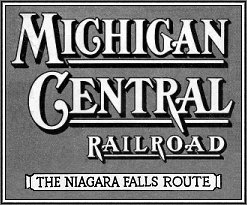 The MCRR was established in 1846 to acquire the state owned Central Railroad of Michigan, a poorly constructed line between Detroit and Kalamazoo, Michigan. Terms of the deal included replacing the cheap rail on the existing line and continuing construction west to Lake Michigan. It was assumed that cargo for Chicago would then be forwarded via lake boat. MCRR did build to the lake at New Buffalo (and not St. Joseph as intended by the state) because the new owners wanted to get to Chicago on their own rails and New Buffalo was on the way. Railroads were acquired to cross the corner of Indiana and into Illinois. The last few miles of the 270 mile line into Chicago were on trackage rights on Illinois Central. Service from Chicago to Detroit opened in 1852. After about 1867 the railroad was controlled by the New York Central Railroad.
The MCRR was established in 1846 to acquire the state owned Central Railroad of Michigan, a poorly constructed line between Detroit and Kalamazoo, Michigan. Terms of the deal included replacing the cheap rail on the existing line and continuing construction west to Lake Michigan. It was assumed that cargo for Chicago would then be forwarded via lake boat. MCRR did build to the lake at New Buffalo (and not St. Joseph as intended by the state) because the new owners wanted to get to Chicago on their own rails and New Buffalo was on the way. Railroads were acquired to cross the corner of Indiana and into Illinois. The last few miles of the 270 mile line into Chicago were on trackage rights on Illinois Central. Service from Chicago to Detroit opened in 1852. After about 1867 the railroad was controlled by the New York Central Railroad.
Vanderbilt interests had been buying shares in MCRR since 1869 and had been trying to acquire the Great Western Railway between Niagara Falls, New York and Windsor, Ontario (just across the river from Detroit.) The goal was to have a second through route between Buffalo and Chicago. Vanderbilt was rebuffed by Great Western and instead began acquiring shares of Canada Southern which accomplished the same goals. In 1882, he arranged for Michigan Central to lease the Canada Southern. MCRR also built and acquired routes to Grand Rapids, Bay City and all the way to Mackinaw City at the northern tip of Michigan’s lower peninsula. In Chicago, MCRR used Illinois Central’s Central Station rather than LaSalle Street Station used by NYC’s other subsidiaries in the city. As early as 1904, New York Central Lines logos began appearing on Michigan Central cars.
Prior to the automobile age, much of the freight traffic originated on the MCRR was tied to the forestry trade. The transformation of Detroit into a center of manufacturing also affected the MCRR with huge volumes of raw materials headed for the city and finished goods moving out.
The Detroit River crossing had become a bottleneck. In 1905, a fleet of four MCRR car ferries were moving on average a thousand cars per day between the U.S. and Canada. In 1910, a new tunnel was opened under the river. The line was electrified to avoid the obvious issues of running steam locomotives thorugh such a long bore. MCRR would acquire a fleet of six Alco GE 1200hp electric locomotives for this service. In 1930 Michigan Central was leased by New York Central, relegating it to the status of paper railroad.
Text Courtesy of Craig Ross of Bluford Shops

Vanderbilt interests had been buying shares in MCRR since 1869 and had been trying to acquire the Great Western Railway between Niagara Falls, New York and Windsor, Ontario (just across the river from Detroit.) The goal was to have a second through route between Buffalo and Chicago. Vanderbilt was rebuffed by Great Western and instead began acquiring shares of Canada Southern which accomplished the same goals. In 1882, he arranged for Michigan Central to lease the Canada Southern. MCRR also built and acquired routes to Grand Rapids, Bay City and all the way to Mackinaw City at the northern tip of Michigan’s lower peninsula. In Chicago, MCRR used Illinois Central’s Central Station rather than LaSalle Street Station used by NYC’s other subsidiaries in the city. As early as 1904, New York Central Lines logos began appearing on Michigan Central cars.
Prior to the automobile age, much of the freight traffic originated on the MCRR was tied to the forestry trade. The transformation of Detroit into a center of manufacturing also affected the MCRR with huge volumes of raw materials headed for the city and finished goods moving out.
The Detroit River crossing had become a bottleneck. In 1905, a fleet of four MCRR car ferries were moving on average a thousand cars per day between the U.S. and Canada. In 1910, a new tunnel was opened under the river. The line was electrified to avoid the obvious issues of running steam locomotives thorugh such a long bore. MCRR would acquire a fleet of six Alco GE 1200hp electric locomotives for this service. In 1930 Michigan Central was leased by New York Central, relegating it to the status of paper railroad.
Text Courtesy of Craig Ross of Bluford Shops
Brand/Importer Information: Brooklyn Locomotive works is a hobby shop that is located in Manalapan, New Jersey. Pete A. Postel founded BLW in 1979. They specialize in N Scale although they claim to cover other scales as well. In addition to serving as a volume discounter with competitive pricing for N Scale hobbyists, Brooklyn Locomotive works also often works with various manufacturers to create their own line of branded special runs. These special runs are usually only available through their retail operation (online or storefront). They also worked for a limited time in the early 1980s as a custom decorator. They bought undecorated kits from Micro-Trains and painstakingly custom painted and decaled a series of cars for collectors.
Manufacturer Information:  Kadee Quality Products originally got involved in N-Scale by producing a scaled-down version of their successful HO Magne-Matic knuckle coupler system. This coupler was superior to the ubiquitous 'Rapido' style coupler due to two primary factors: superior realistic appearance and the ability to automatically uncouple when stopped over a magnet embedded in a section of track. The success of these couplers in N-Scale quickly translated to the production of trucks, wheels and in 1972 a release of ready-to-run box cars.
Kadee Quality Products originally got involved in N-Scale by producing a scaled-down version of their successful HO Magne-Matic knuckle coupler system. This coupler was superior to the ubiquitous 'Rapido' style coupler due to two primary factors: superior realistic appearance and the ability to automatically uncouple when stopped over a magnet embedded in a section of track. The success of these couplers in N-Scale quickly translated to the production of trucks, wheels and in 1972 a release of ready-to-run box cars.
In October 1990 Kadee separated in two companies, with the newly created Micro-Trains® Line Co. continuing the Z, Nn3, and N Scale product ranges, with Kadee retaining the HO range.

In October 1990 Kadee separated in two companies, with the newly created Micro-Trains® Line Co. continuing the Z, Nn3, and N Scale product ranges, with Kadee retaining the HO range.
Commissioner Information: Brooklyn Locomotive Works was a hobby shop, specialized in N-scale, located in Manalapan, New Jersey, that also sells on-line. BLW regularly commissions special runs.
The company was founded by Pete Postel who announced that he would retired by end of 2018. His brother Paul should continue the business from his own shop Hogtrainz.com.
Brooklyn Locomotive Works (BLW) released special runs from various manufacturers under its own brand until approx. the mid-1980s. Thereafter the special runs where sold under the manufacturer's name and denoted as special runs for BLW. Hence in this database, we assign the BLW brand in the former case, and the original manufacturer's brand in the latter.
The company was founded by Pete Postel who announced that he would retired by end of 2018. His brother Paul should continue the business from his own shop Hogtrainz.com.
Brooklyn Locomotive Works (BLW) released special runs from various manufacturers under its own brand until approx. the mid-1980s. Thereafter the special runs where sold under the manufacturer's name and denoted as special runs for BLW. Hence in this database, we assign the BLW brand in the former case, and the original manufacturer's brand in the latter.
Item created by: nscalemodeler160 on 2016-04-08 04:57:57. Last edited by gdm on 2020-06-04 14:03:36
If you see errors or missing data in this entry, please feel free to log in and edit it. Anyone with a Gmail account can log in instantly.
If you see errors or missing data in this entry, please feel free to log in and edit it. Anyone with a Gmail account can log in instantly.


